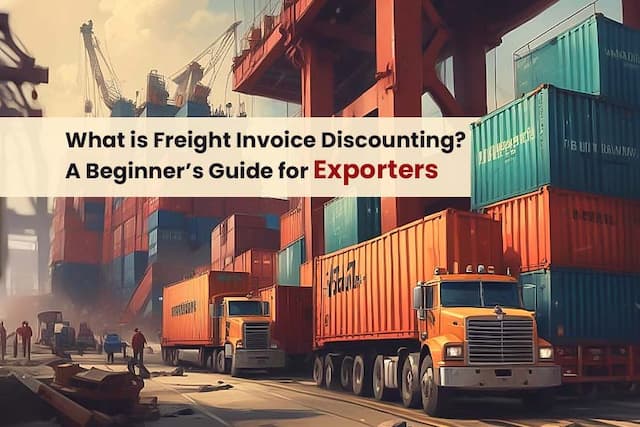In order to unlock short-term working capital in the current trade finance arena, the two powerful tools that can help businesses are bill discounting and freight invoice discounting. The two methods convert cash into receivables. Although each has different compliance requirements in different industries. By learning the clear differences and similarities between bill discounting and freight invoice discounting, exporters and financiers will make the most optimal decisions when it comes to their cash-flow needs.
What Is Bill Discounting?
Bill discounting is an old-fashioned financing technique where a business sells their accepted bills of exchange to a bank or financial institution before the maturity date. On submitting the bill and other trade documentation, the seller obtains upfront cash after reducing a small discounting fee. This advance access to funds assists the manufacturers, exporters, and wholesalers in retaining a liquid state as they await the buyers to pay them.
What Is Freight Invoice Discounting?
The freight invoice discounting is based on the same principle, but focuses on logistics and shipping services. Exporters or transportation companies pay an unpaid freight bill to a finance company, which advances the majority of the bill value. The financier resorts to the buyer and takes the amount when the payment falls due. Freight invoice discounting ensures that shipping activities continue to run smoothly without the need to wait for lengthy payment cycles.
Core Similarities Between the Two
The similarities between bill discounting and freight invoice discounting have a number of common advantages regardless of the industry differences. Both turn receivables into immediate cash, enhance cash flow, and diminish the reliance on long-term loans. They both involve the presentation of verified trade papers, risk evaluation by the financier, and payment of a discount fee. These financing choices are also affordable short-term funding options that lower the costs of borrowing and boost working capital in businesses with high receivables.
Key Differences in Underlying Assets
The major difference is the nature of the receivables. Bill discounting applies to bills of exchange or trade bills, which are secured by goods or services, whereas freight invoice discounting is based on invoices of shipping and transportation services. Financiers dealing with invoice discounting of freight invoices should consider various risk factors other than those that are used on normal trade invoices. They need to do it as freight invoices normally contain variable costs like fuel surcharges or customs duties.
- Regulatory and Compliance Variations
The regulation is also different. Bill discounting is generally a banking regulation and a trade finance standard, whereas freight invoice discounting is a logistics agreement and might need tax-compliant industry standards such as Goods and Services Tax (GST). To be within the bounds of the law, exporters on freight invoice discounting should be cautious in the way they handle GST invoices, input tax credit claims, and international shipping documents.
- Cash-Flow Impact and Speed
These two methods have a quicker cash flow; however, freight invoice discounting is usually quicker since shipping invoices receive a raise as soon as the service is completed. Under bill discounting, the banks can carry out further credit checks on the buyer before the release of funds. The rate of freight invoice discount can be a game-changer in the case of logistics companies whose business is built on thin margins.
- Risk Management Considerations
Risk exposure varies as well. The risk of the buyer not honoring the bill of exchange is the main risk in bill discounting. In the case of freight invoice discounting, financiers look at the reputation of the shippers, freight forwarder, and final client. Financiers who provide freight invoice discounting should consider the risk of transit and exchange rate differences, as international shipments might become delayed.
- Industry Suitability
Bill discounting applies to manufacturers, traders, and exporters of physical goods, and freight invoice discounting applies to logistics providers, freight forwarders, and shipping companies. Freight invoice discounting suits better businesses that are in the habit of issuing freight invoices, including transport operators and customs brokers, as it perfectly fits their business requirements.
Financial Planning Advantages
Budgeting and steady cash flow are guaranteed with the help of strategic application of bill discounting or freight invoice discounting. Businesses are able to align the inflows and the outflows, compensate the suppliers on time, and strike improved terms of purchase. Combining either way of financing into a larger treasury plan will decrease dependence on loans at high interest rates and improve the overall financial picture.
Choosing the Right Option
Choosing between the discounting of bills and the discounting of freight invoices relies on the business model. Exporters who have both product sales and shipping services may even bundle the latter to get the best liquidity. Assessment of payment cycles, risk tolerance, and documentation capacity ensures that the selected approach facilitates growth in the long term.
Final Insights on Bill vs. Freight Invoice Discounting
Companies that need access to funds on time need to know the details of both types of discounting. Both approaches transform the receivables into cash; however, the documents, risk profile, and compliance needs are different. The businesses can choose the most appropriate financing option to provide good liquidity and less risk by examining the type of transactions and the needs of the industry.
Credlix offers transparent and quick freight invoice discounts to exporters and logistics companies. Credlix helps businesses to keep running, to pay suppliers on time, and to grow without the long payment cycle by converting unpaid freight invoices into instant working capital. Credlix is an expert provider of compliance and competitive prices with financial agility among firms that require it.
FAQs
What is the difference between bill discounting and freight invoice discounting?
Bill discounting is the selling of trade bills secured by goods or services, and freight invoice discounting is the process that deals with shipping or transportation invoices.
Is it possible to have a combination of the two methods of financing?
Yes. A goods-selling company with its own logistics can bundle bill discounting on the sale of goods with freight invoice discounting for shipping of the goods.
Is GST the freight invoice discounting?
Yes. GST is imposed on the freight service and the discounting fee charged by the financier, but the financing transaction might be considered distinct from the freight charge.





